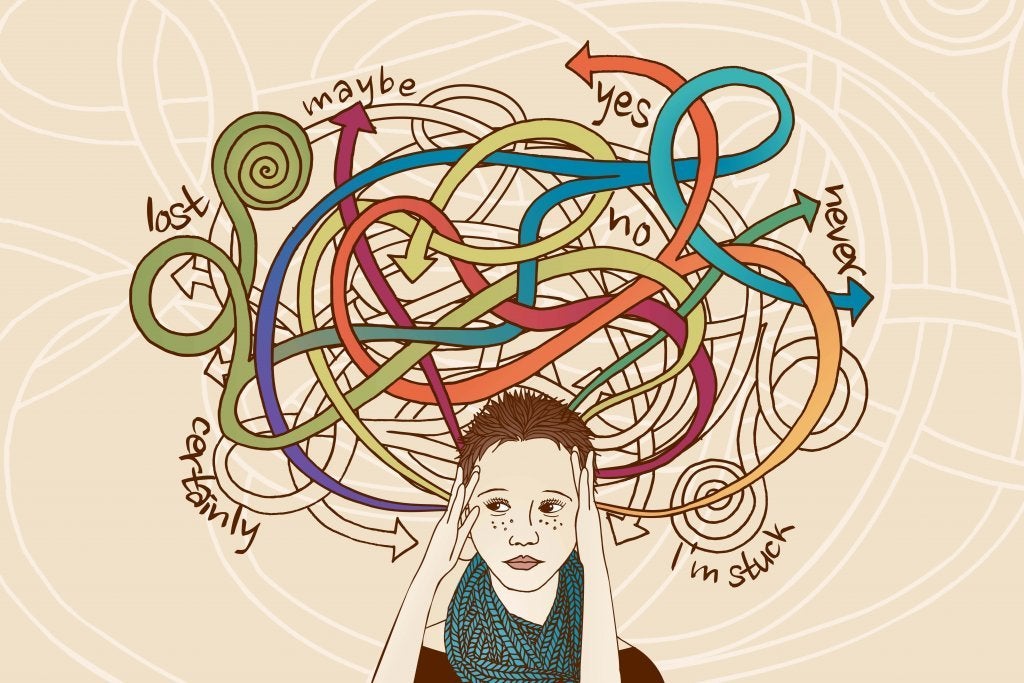Thinking too much about something, or worrying more than usual by thinking about things down to the smallest detail, is a habit that more and more people suffer from and that undoubtedly reduces one’s quality of life. Although almost everyone seems to have an advice on this subject, stereotypical suggestions such as meditate or breathe are not very helpful if you have started to experience the physical harms of stress as well as the mental effects.
As someone who pays attention to the smallest details about every subject and experiences firsthand the negative effects of constant worry and stress, I have compiled 6 items that I believe will be more effective than stereotypes that I have seen in different sources:
…
1) Realizing that you think more than you should, is the first step to get rid of this feature.

What you need to do before dealing with this habit is to be able to identify the times when you start to think too much. Whenever you feel anxious, suspicious, or stressed, take a step back and try to look at your situation not as inside but as an outside eye that observes and will not be affected by the consequences of your actions. This momentary awareness is actually the key to changing your approach to the subject.
2) Consider the situation from different perspectives and frameworks.

It’s always easier to treat things as bigger and worse than they are, and we always tend to do so.
The next time you realize you’re making the flea a camel, ask yourself how important it will be in your life in five years’ time. Or, within 1 month, depending on the situation. With just this simple question, you can change the time frame and stop the flow of anxious thoughts that you can’t control as if you’ve pushed a button.
3) Take a certain amount of time for yourself to overthink.

The first time you read it, you may have had difficulty understanding how this sentence will help you. On the other hand, dedicating a certain amount of time to overthinking and worrying, for example contemplating all possible failure scenarios of a plan you have made, or spending 20 minutes thinking about things that you might have done differently in the past, can help prevent these negative thoughts from affecting you all day long. It may be more useful than you think.
You are free to worry about in this time frame, in other words, there is no limit to what you think about. But other than this time, instead of spending time on such worry-based thoughts, go about your daily business by postponing them to the next time you set aside for overthinking. Postponing rather than trying to suppress it is definitely a very useful way to get rid of your anxious thoughts, as trying to suppress something, as you are familiar with, often results in the opposite effect, while procrastination is very effective in reducing its intensity or intensity.
4) Replace your subject, that is, change your focus.

The more you try to ignore something, the more often it pops into your mind and your efforts backfire. There are two things you can do at this point: first, to occupy yourself with another activity (short-term solution), and secondly, to replace the object of your concern for another (long-term solution).
Another activity might be tiring yourself out physically, chatting with a friend, working on a project, or even getting a good night’s sleep, so even taking a 20-minute nap is good. This is how you can distract your thoughts by keeping yourself busy.
As a long-term solution, object swapping is a step you can take after you identify the point where your worries or negative emotions are headed. Suppose you have a loved one who passed away and you regret not being able to give them the attention and affection you wanted before you lost them. At this point, changing objects means that you put aside the regret and show the interest and support that you regret not being able to show the person around you.
If you feel low on mood because of an argument with a friend, another example would be to have a good time with other people around you instead of focusing on your low mood.
5) Heed the Indian teaching: focus on what you do rather than results.

In the Mahabharata epic, which is the longest poem ever written, it is emphasized that there are four purposes of human existence in general: virtue and moral behavior rules, dharma, artha, which is depicted as purpose, reason and motive, kama, which symbolizes emotional pleasure and desire, and finally liberation and liberation. namely Moksha.
The Bhagavad Gita, which is perhaps the most well-known of the 18-part Indian epic, focuses on dharma and is based on the following message: fulfilling our mission in life and achieving happiness lies in focusing only on the effort we have to put in and not thinking about the results of this effort.
Focusing on the results (like if I fail the exam, it is impossible for me to pass the course) increases the stress and reinforces the belief in the uncertainty of the result. On the other hand, focusing on the work you are doing, or your work, means that we turn to something that is within your control, and so your tension increases in parallel with it.
6) Solve someone else’s problem and gain a new perspective.

Begin by adopting the motto first help, then think, and try to help anyone around you who has a problem. Sometimes you are so focused on your own problems that you find it difficult to see a solution that is actually in front of you. Considering what advice you would give to someone who has a similar problem, you can get a clearer view by pulling yourself out of the business at this point.















